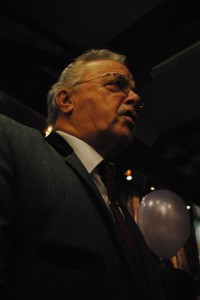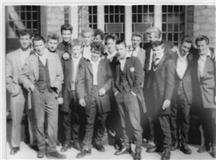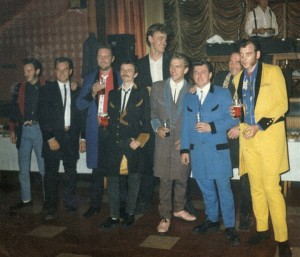Home & Welcome
Quiffs and collars,fops or fighters?
It’s 50 years since Edwardian jackets,drainpipe trousers and DA hairstyles suddenly appeared on Englands city streets.PETER RHODES recalls the rise of the Teddy Boys.
Oct13,2004,
Look around at the old blokes in a pub or the pensioners in the post – office queue.What were they doing 50 add years ago? It’s a fair bet that some of them were pulling on stylish Edwardian coats and drainpipe trousers for a night – maybe a fight- in town. Half a century ago the Teddy Boy emerged in England.But with hindsight,do we remember them fondly,or think of the dark side? While everyone remembers the flashy clothes and the rock-and-roll dance sessions,Teddy Boys were also implicated in the first racial attacks and full race riots seen in Britain.  The BBC recorded the 50th anniversary at the weekend in Ready Teddy (Radio 4) Ray Gosling,who claims to be one of Britains first Teddy Boys,took a nostalgic trip to his home town of Northampton. He met the barber who gave him his first quiff.He recalls how the Teds marked the gradual end of the austere world of postwar rationing.But Gosling is big enough to except that these working-class dandies were no angels.
The BBC recorded the 50th anniversary at the weekend in Ready Teddy (Radio 4) Ray Gosling,who claims to be one of Britains first Teddy Boys,took a nostalgic trip to his home town of Northampton. He met the barber who gave him his first quiff.He recalls how the Teds marked the gradual end of the austere world of postwar rationing.But Gosling is big enough to except that these working-class dandies were no angels. Teds and trouble seemed to go together.In Febuary 1957 a group of Teddy Boys posed peacefully for the Express & Star,prompting the newspaper to comment ” Not everyone who wears Edwardian clothes is a delinquent. Yet before long the trail of street fights,wrecked cinemas,jukeboxes and milk bars horrified Middle England. In 1958,the infamous Notting Hill race riots kicked off with attacks on black people by Teddy Boys associated with the fascist British Union. The Express & Star reported on April 6,1959 that 30 Teddy Boys had attacked a group of black men outside the Pavilion dance hall in High Street,Blackheath.The incident was described as the town’s “first racial street fight”. In 1961 hundreds of recruits from RAF Cosford marched to a dance hall in Albrighton after Teds beat up two of their comrades.Local police defused the situation by promptly arresting the teds. The Teddy Boy phenomenon first hit the headlines in London in March 1954 in a court case in Dartford.Someone had pulled the communication cord on a late-train.The police arrived and arrested a gang dressed in Edwardian suits. A magistrate sneered at the Teds clothes:” They are ridiculous in the eyes of ordinary people.They are flashy,cheap and nasty and stamp the wer#arer as a particulary undesirable type”. But the Teddy Boy myth was born.In August 1954 the first “Best dressed Ted” contest was held on Canvey Island. The ‘Ted’ fashion had curious origins. After the Second World War,some gays in London began wearing long Edwardian jackets with velvet collars.The trend was taken up by young upper-class officers in the Guards to reflect a longing for the lost grandeur of Edwardian England. The style quickly moved downmarket into working-class London and then to the provinces.Hairstyles changed overnight.Out went the traditional short back and sides.In came the Brylcreemed quiff with the hair cut into a DA (ducks a***) at the back. The Ted style may have started in tribute to Edwardian England but the Teds qutckly adapted their look to the Wild West,as seen in a host of post-war movies. Narrow ties gave way to bootlace ties,held together,Texa-style,with crossbones or dollar sign medallion.Teddy girls wore tight-waisted skirts over massive net petticoats,topped off with beehive hairdos. But if the Teds looked smart on the outside,those cavernous frock coat pockets might have contained anything from a flickkife to a bicycle chain. For thousands of lads,being a Ted Boy was a rite of passage for the years between adolescence and National Service and whatever fate held in store in Cyprus,Malaya or Suez. They may have been the terror of the milk bars and dance halls but once inside an army camp,the hardest Ted was broken by ferocious NCOs.Quiffs that took years to produce fell in a matter of seconds to the base barbers clippers.The process reduced many teds to tears. By the mid-1960s the last Teddy Boys completed National Service came home to find the world had changed utterly.Mods and Rockers were scrapping on the seafront at Clacton and the Teddy Boys passed into history.
Teds and trouble seemed to go together.In Febuary 1957 a group of Teddy Boys posed peacefully for the Express & Star,prompting the newspaper to comment ” Not everyone who wears Edwardian clothes is a delinquent. Yet before long the trail of street fights,wrecked cinemas,jukeboxes and milk bars horrified Middle England. In 1958,the infamous Notting Hill race riots kicked off with attacks on black people by Teddy Boys associated with the fascist British Union. The Express & Star reported on April 6,1959 that 30 Teddy Boys had attacked a group of black men outside the Pavilion dance hall in High Street,Blackheath.The incident was described as the town’s “first racial street fight”. In 1961 hundreds of recruits from RAF Cosford marched to a dance hall in Albrighton after Teds beat up two of their comrades.Local police defused the situation by promptly arresting the teds. The Teddy Boy phenomenon first hit the headlines in London in March 1954 in a court case in Dartford.Someone had pulled the communication cord on a late-train.The police arrived and arrested a gang dressed in Edwardian suits. A magistrate sneered at the Teds clothes:” They are ridiculous in the eyes of ordinary people.They are flashy,cheap and nasty and stamp the wer#arer as a particulary undesirable type”. But the Teddy Boy myth was born.In August 1954 the first “Best dressed Ted” contest was held on Canvey Island. The ‘Ted’ fashion had curious origins. After the Second World War,some gays in London began wearing long Edwardian jackets with velvet collars.The trend was taken up by young upper-class officers in the Guards to reflect a longing for the lost grandeur of Edwardian England. The style quickly moved downmarket into working-class London and then to the provinces.Hairstyles changed overnight.Out went the traditional short back and sides.In came the Brylcreemed quiff with the hair cut into a DA (ducks a***) at the back. The Ted style may have started in tribute to Edwardian England but the Teds qutckly adapted their look to the Wild West,as seen in a host of post-war movies. Narrow ties gave way to bootlace ties,held together,Texa-style,with crossbones or dollar sign medallion.Teddy girls wore tight-waisted skirts over massive net petticoats,topped off with beehive hairdos. But if the Teds looked smart on the outside,those cavernous frock coat pockets might have contained anything from a flickkife to a bicycle chain. For thousands of lads,being a Ted Boy was a rite of passage for the years between adolescence and National Service and whatever fate held in store in Cyprus,Malaya or Suez. They may have been the terror of the milk bars and dance halls but once inside an army camp,the hardest Ted was broken by ferocious NCOs.Quiffs that took years to produce fell in a matter of seconds to the base barbers clippers.The process reduced many teds to tears. By the mid-1960s the last Teddy Boys completed National Service came home to find the world had changed utterly.Mods and Rockers were scrapping on the seafront at Clacton and the Teddy Boys passed into history. 
__________________________________________________________________________________________
Around 1950, a couple of London tailors produced a suit which was based on an old Edwardian fashion. The jacket was long with narrow lapels and waisted. It was worn with fairly narrow trousers. Suggested additions were steel toe capped shoes and fancy waistcoat. This suit was aimed at the “wealthy young man about town” (Rogers 1982). However, the story goes, the suit was purchased by a few working class lads from the East End of London with their “spare” cash. The purchase of this suit was, according to Jefferson (1976 pp85), “an attempt to gain status (since the clothes chosen were originally worn by upper class dandies)” . This I would agree with and add that a “gang” which the working class purchasers more than likely belonged to , found a means of expressing themselves and their territory through it. Youth gangs were not just emerging at that time but were fairly commonplace before. The adoption of an Edwardian style suit was the first use of a clothing symbol to give a feeling of status; not just because they lacked it in society in general but also because the initial gang wanted status over other gangs. Further modifications to the original suit were the wearing of drainpipe trousers, crepe sole shoes, bootlace tie and DA (duck’s arse) haircut. As far as I can gather from older informants, some of the adaptations were used also as an attempt by gangs to distinguish themselves from others when the basic style became popular.
Teddy Boy (also known as Ted) is a British subculture typified by young men wearing clothes that were partly inspired by the styles worn by daddies in the Edwardian period styles which Savile Row tailors had attempted to re-introduce in Britain after World War II!!.The subculture started in London in the 1950s, and rapidly spread across the UK, soon becoming strongly associated with American rock n roll. Originally known as Cosh Boys, the name Teddy Boy was coined when a 1953 Daily Express newspaper headline shortened Edwardian to Teddy.
Wealthy young men, especially Guards officers, adopted the style of the Edwardian era.At that point in history, the Edwardian era was then just over 40 years previous, and their grandparents, if not their parents, wore the style the first time around. The original Edwardian revival was far more historically accurate in terms of replicating the original Edwardian era style than the later Teddy Boy style. It featured tapered trousers, long jackets that bear a similarity to post-war American Zoot suits and fancy waist coats.
Although there had been youth groups with their own dress codes called Scuttlersin 19th century Manchester and Liverpool,Teddy Boys were the first youth group in England to differentiate themselves as teenagers helping create a youth market. The US film Black Board Jungle marked a watershed in the United Kingdom. When shown in Elephant and Castle, south London in 1956, the teenage Teddy boy audience began to riot, tearing up seats and dancing in the cinema’s aisles.After that, riots took place around the country wherever the film was shown.
Some Teds formed gangs and gained notoriety following violent clashes with rival gangs which were often exaggerated by the popular press. The most notable were the 1958 Notting Hill race riots, in which Teddy Boys were present in large numbers and were implicated in attacks on the West Indiancommunity. The violent lifestyle was sensationalised in the pulp novel Teddy Boy by Ernest Ryman, first published in England in 1958.
Teddy Boy clothing included drape jackets reminiscent of 1940s American zoot suits worn by Italian Americans,Chicano and African American communities (such as Cab Calloway or Louise Jorden), usually in dark shades, sometimes with a velvet trim collar and pocket flaps, and high-waist drainpipe trousers often exposing the socks. The outfit also included a high-necked loose-collared white shirt (known as a Mr. B. collar because it was often worn by jazz musician Billy Eckstine); a narrow “Slim Jim” tie or western Maveric tie, and abrocade waist coat. The clothes were mostly tailor-made at great expense, and paid for through weekly installments.
Favoured footwear included highly polished Oxford chunky brogues and crepe-soled shoes, often suede(known as brothel creepers). Preferred hairstyles included long, strongly-moulded greased-up hair with a quiff at the front and the side combed back to form a duck’s arseat the rear. Another style was the “Boston”, in which the hair was greased straight back and cut square across at the nape.
Although Teddy Boys became associated with rock n roll music, prior to the advent of that genre, Teddy Boys mainly listened and danced to jazz and Skiffle music.A well-known dance that the Teddy Boys adopted was The Creep, a slow shuffle that was so popular with Teddy Boys that it led to their other nickname, Creepers. The song “The Creep” came out in 1953, and was written and recorded for HMV by Yorkshire-born big band leader and saxophonist Ken Macintosh. Although this was not a rock and roll record, it was widely taken on by the Teddy Boys of the time. From 1955, rock and roll was adopted by the Teddy Boys when the film, Blackboard Jungle, was first shown in cinemas in the UK, and Teddy Boys started listening to artists like ElvisPresley, Bill Haley and Eddie Cochran.
During the 1970s, Rockabilly music enjoyed a renewed period of popularity and there was a resurgence of interest in Teddy Boy fashions. The look was promoted by Vivianne Westwoodand Malcolm Maclaran through their shop Let it Rock, on London’s Kings Road. This new generation of Teds adopted some aspects of the 1950s but with a large glam rock influence, including louder colours for drape jackets, brothel creepers and socks, and shiny satin shirts worn with bootlace ties, jeans and big-buckled belts. The 1970s Teddy Boys often sported flamboyant pompadour hairstyles in addition to long sideburns and were alleged to prefer hairspray over grease to style their hair. In the late 1970s, the new generation became the enemies of the Westwood and Sex Pistol-inspired punk rockers. In the spring of 1977, street battles between young punks and aging teds happened on the London King’s Road, where the earliest new wave shops, including Vivienne Westwood and Malcolm McLaren‘s Sex (by now not selling zoot suits and ted gear anymore), were situated.
John Facer formed the D.O.N.S (the Drapes Of Northampton Society) in 2005 to try to unite teddy boys & girls worldwide.The Edwardian Teddy Boy Association was formed in 2007 and has continued the work of reviving the original 1950s Teddy Boys style. In 2010, a new group of Teddy Boys surfaced in Manchester, known as The Manchester Peacock Society. The group in the main were Teddy Boys during the 1970s, and most were former members of the Salford Bop Cats. The group also have a number of original Teddy Boys in their ranks, who are in their seventies. The principal aim of the Manchester Peacocks is to promulgate the original style of the pre-1955 Teddy Boy and actively promote the ethos and style of the original and authentic British Teddy Boy movement. The group, although growing in numbers are limiting their membership to 100 members as a means of maintaining an authentic image.
The aim of this site is to promote the uniting of Teddy Boys, not only here in the UK but worldwide.There seems to be a lot of ‘us and them’ going on these days.The argument of whether you are called an edwardian teddy boy or just a teddy boy.The teddy boy has worn dark or grey suits,as in the 50s,to bright coloured suits in the 70s.As some of us have grown older we have reverted to wearing more somber colours.
Edwardian teddy boy or just teddy boys,…..whats the difference?So it doesn’t matter if you wear a dark drape or a more colourful one, we all wear a long jacket.
Definition of Teddy boy
noun
(in the 1950s) a young man of a subculture characterized by a style of dress based on Edwardian fashion (typically with drainpipe trousers, bootlace tie, and hair slicked up in a quiff) and a liking for rock-and-roll music.
Origin:
from Teddy, pet form of the given name Edward (with reference to the reign of Edward VII )
Leave a Reply
You must be logged in to post a comment.



